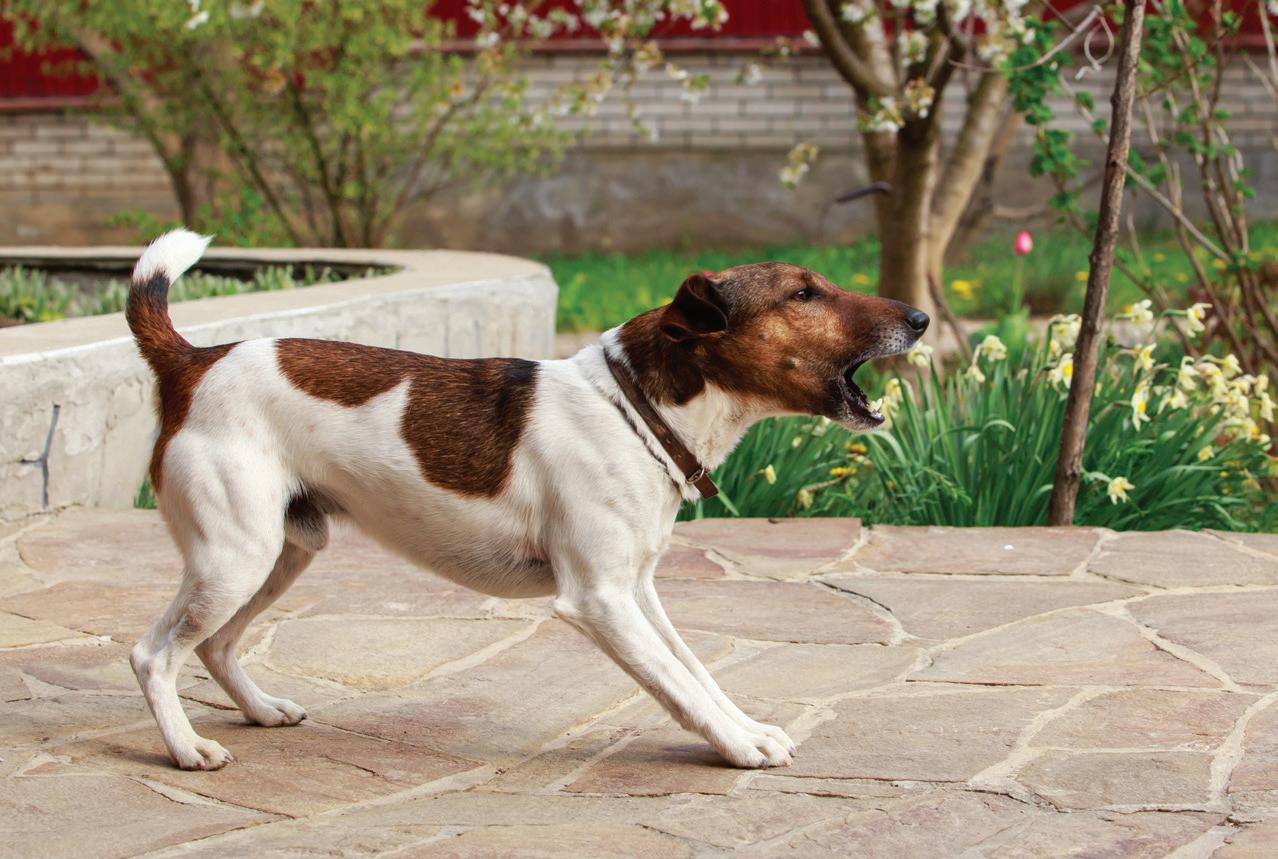
9 minute read
Understanding Barking Elections
from November 2021
by dogsnsw
FEATURE
Understanding Barking
Reprinted with permission of Bow Wow Meow Pet Insurance
One of the questions most frequently asked by dog owners is how to stop a dog from barking. Statistics suggest that excessive barking may well be the most significant behavioural issue confronting dog owners, and in Australia, barking is the second most common complaint made to local councils 1.
Continuous and excessive barking can indeed be highly problematic for dog owners and their neighbours alike. It is important to understand that barking is a natural behaviour for dogs. They are social animals who interact with one another, and with us humans, through vocalisations and body language. Dogs have a wide range of vocalisations – apart from barking, they whine, growl, howl, whimper, yip and yelp. We cannot expect dogs to be silent when vocalising is part of their nature; however, there is a difference between ‘normal’ and acceptable levels of barking, and continuous, excessive barking that disturbs the peace and causes discomfort for those in hearing range.
Why do dogs bark?

We know that in the wild, dogs bark to communicate, particularly when they cannot immediately see the rest of the pack, or when they want to get a message to the entire pack – a warning of danger, a call to the hunt or a way to scare off a threat. Domesticated dogs live in a very different world from their wild ancestors, but their instincts and drives remain very much the same. Often, their barking is a perfectly natural canine response to a stimulus in the environment, such as another dog passing by or a stranger knocking on the door. They may also bark when they are exposed to new or unusual stimuli, including sounds, sights or odours, during times of indecision, anxiety, or frustration, and when in pain or discomfort. Some dogs also bark because they are excited and sometimes, they may appear to bark without any obvious reason at all.
• Barking as an alert or alarm

• Barking as a threat or territorial warning
Alert barking can occur in response to real threats (for example, a dog or stranger approaching) or to a stimulus (a noise or unfamiliar object) that has startled or excited the dog. Short, sharp and repetitive, the purpose of the alert bark is to call out to his pack or his people to join him in the face of an emergency, much like a siren or an alarm would, thus its intensity is difficult to ignore. The dog may peer out the windows, tilt his head and try to locate the source of the disturbance. Alert barking can happen anywhere, not just at home.
For hundreds of years, humans selected dogs purposely for their ability to alert and it was a highly desirable trait. Nowadays, in many parts of the world, society is very different. High and medium-density urban living doesn’t encourage alert barking anymore, but the genetical roots are deep for this behaviour in the dog.
A threatening bark is sending a territorial warning to let non-pack members know that this is his territory and he’ll do anything in order to protect it. The barking often gets louder and harsher as the threat gets closer, and the dog looks alert and aggressive. This type of barking is common behaviour in the many guard dog breeds. Protective and guarding instincts have been honed over hundreds of years in these breeds, so it is no wonder that they bark at strangers or other animals approaching their homes. Guarding breeds prone to this type of barking include: German Shepherd Dog, Doberman Pinscher, Rottweiler, Bullmastiff, Schnauzer, Boxer, Rhodesian Ridgeback, Akita, Belgian Shepherd (Malinois), Komondor, Cane Corso.
Separation anxiety can occur when a dog who is very attached to his owner is left alone at home. In addition to continual barking, a dog that suffers from separation anxiety may howl, whine, pace intensely and engage in destructive activities such as chewing on furniture, frantic scratching on doors or windows and ripping up pillows or clothing.
The excessive barking and destructive behaviours associated with separation anxiety are an attempt by the dog to relieve his stress, and they typically happen every time the owner leaves, and only in his or her absence. Sometimes, they may begin even before the owner leaves; for example when he or she put on a coat or takes out the car keys. In many cases, however, these behaviours begin soon after the owner leaves and he or she may be unaware just how distressed their dog is and how persistent his barking is, during the periods of absence.
Separation anxiety can occur in response to major changes in the environment; for example, moving to a new house, a family member leaving the home or a new one joining the home, or even a sudden change in schedule. While all breeds can suffer from separation anxiety, some breeds appear to be prone to it, especially the more people-oriented breeds, including Labrador Retriever, Chihuahua, Border Collie. Cavalier King Charles Spaniel, Jack Russell Terrier, German Shepherd Dog, Cocker Spaniel, Australian Shepherd, Bichon Frise, Hungarian Vizsla, German Shorthaired Pointer, and Toy Poodle. For tips on how to avoid separation anxiety: https://bowwowinsurance.com.au/pet-community/pet-talk/tips-to-avoid-separation-anxiety-in-dogs
• Barking when experiencing fear
Dogs may bark excessively when startled, afraid, uneasy or stressed. Barking is a way of dogs to communicate to the threat to move away, e.g. when dogs bark at an unusual item or person on their walk. Many dogs are frightened during noisy events such as thunderstorms or fireworks and will bark excessively in response.
• Barking when bored or lonely
Barking to communicate feelings of boredom, unhappiness or frustration can occur when the dog is alone at home or confined to the backyard with not much to occupy himself. This behaviour can often be seen in dogs that have been selectively bred for working dog roles, either directly or through their close ancestors, when they are left without a job for long periods at the time.
Dogs are pack animals who enjoy interacting with their humans and/or other dogs. A dog who is howling is thought to be a calling out to those around him that he is alone and desperate for some company. Dogs that are really bored might bark to just entertain themselves; they might not be barking at anything at all, just barking because it’s less boring than doing nothing. Some dogs bark non-stop whenever they are outside, because of a lack of stimulation; barking is their way to release excess energy.
• Barking when seeking attention or wanting something

Dogs often bark when they want something, such as to be let into or out of the house or to be fed. They may also bark to get attention from people. Dogs learn quickly that barking at people often makes those people give them what they want, which quickly creates a strong habit of barking to get what they want. This type of barking can be constant and non-stop, causing much frustration for owners and neighbours.
• Barking when excited
Dogs bark when expressing their excitement, particularly when a family member arrives home, when they are playing, or when they encounter other dogs in their social group. In these situations, barking is a greeting, a happy bark accompanied by a wagging tail and sometimes jumping.
Some dogs bark more than others
All dogs bark, except perhaps for the Basenji, who are known as the “bark-less dogs of Africa”, although they do vocalise with screams, growls and a canine yodel! Some breeds are more excitable and impulsive than others, and many of these have a strong disposition towards excessive barking. By nature, they are very vocal with their barks, howls and yaps, and even with professional training it may be impossible to get them to stop barking.
FEATURE
Some dogs bark more than others

Many working dog breeds were bred to bark because of the job they were required to do. From herding, to flushing out game for hunters, to alerting people to danger or the presence of intruders, many breeds such as Beagles, German Shepherd Dogs and Shetland Sheepdogs were bred in part for their barks.
Breeds that tend to bark more than others include: • Chihuahuas, have a tendency toward yapping, that can be triggered by separation anxiety and potential threats.
They are territorial and don’t like others entering their private space, and they get uneasy when someone gets too close to their favourite humans.
• Yorkshire Terriers are also yappers who find it difficult to be silent, even with proper training and plenty of distractions.
They are territorial, energetic and highly protective – traits which together can lead to almost constant barking. • Jack Russell Terriers (pictured left) love to bark, and a lot of patience, training and dedication (as well as some good earplugs!) are required from their owners to manage this effectively. • Other Terrier breeds are also very keen on vocalising: Boston Terrier, Scottish Terrier, Cairn Terrier, West Highland White Terrier, Fox Terrier and Australian Silky Terrier are all known to be enthusiastic barkers. • Basset Hounds have a classic hound howl that can be heard for miles around when they are left alone at home. As tracking dogs, they have been bred to bark when they suspect that something or someone is nearby. • Miniature Schnauzers are also more likely to bark or yap constantly. They may do so to protect their families and ward off intruders, to assert their dominance or to express their boredom. • Beagles are generally pretty ‘talkative’ but aren’t usually nuisance barkers unless they are bored or lonely. • Keeshond are very protective of their families and like to alert bark whenever something is coming their way. If out in the backyard they will bark almost constantly. • Maltese are a feisty breed who will bark at pretty much anything they encounter, including visitors to your home. • German Spitz are a vocal breed who often bark loudly and sometimes howl, especially around people they don’t know. • Schipperkes are often quick to sound the alarm or to bark for entertainment. • Samoyeds love to bark and have intense, high-pitched barks that can be very annoying for both owners and the neighbours. • Finnish Spitz are also known as Bark Pointers for a good reason – barking is a major part of their hunting activities; it is something they were bred specifically to do.
How to stop a dog from barking

A more realistic question than this is “how to reduce the incidence, intensity and duration of barking?”. Ideally, in most cases barking should serve to get the dog’s intended message across, then cease. Because there are so many possible underlying reasons for the barking, there is no one simple solution to reduce barking behaviour. Getting your dog to bark less will take time, patience, effort and consistency. Sometimes, your best efforts may not produce the desired result and you may need to engage professional help. For more on this topic, with ways to assist with a barking dog, look in the December edition of DOGS NSW Magazine for the second part to this article.
References: 1. https://www.ava.com.au/siteassets/resources/behaviour-resources-for-veterinarians/ fact-sheet-why-does-my-dog-bark.pdf Order your supply of free Puppy Guides:
Bow Wow Meow’s comprehensive Puppy Guide has been written by puppy experts and trainers, and is packed full of practical tips and advice on puppy raising. These 36-page booklets are available free of charge to breeders registered with DOGS NSW to give out to your puppy buyers. To order a supply, please go to www.bowwow.com.au/breeder-registration


